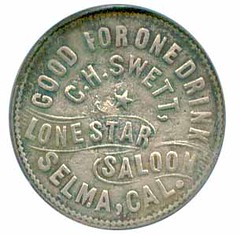
PREV ARTICLE
NEXT ARTICLE
FULL ISSUE
PREV FULL ISSUE
DUANE FEISEL ON PRICES AND VALUES IN NUMISMATIC BOOKSRegarding our earlier discussion of prices, values, and rarity in numismatic books Duane H. Feisel writes: The attached file provides my approach to whether to use price or rarity in a numismatic listing catalog. The answer is neither – value is the key as argued in the attached. This approach was used in my Token and Medal Society Mishler gold medal awarding-winning catalogs of California Encased and Sticker Coins and of Pre-Prohibition California Saloon tokens.
Thanks for providing the text! An extensive excerpt is below. To save space I've edited out a lengthy list of factors that influence the desirability of California saloon tokens, which include attributes common to all numismatic items (like rarity and denomination) and attributes specific to saloon tokens (like an unusual saloon name). An excellent treatment of the subject. For illustration I've included an image of a California saloon token provided earlier by Fred Holabird.
-Editor
Some token catalogs attempt to provide a rarity rating (the number of pieces known to exist) and then relate rarity to value. However, except for a catalog of the most limited scope, it must be recognized that a rarity rating is at best an educated guess. How can the cataloger possibly poll every collector (and non-collector) to create a census for every item in the catalog? That is an impossible task. Even if a fairly accurate rarity can be established, is there really any direct connection between rarity and value? Often, not. Say there is a modern wooden nickel that has been misprinted – only one example exists, so it would be of the highest rarity – it's unique. The only way this item would have any value at all is if there is a demand for it. How many collectors would be interested in a modern misprinted wooden nickel? Probably not very many. The point is, rarity by itself means very little. Demand must be considered. What are some of the factors that affect demand? There probably are as many different approaches to collecting anything as there are collectors interested in a specific item for whatever reason. The number of people wanting a specific item is the demand. Still, demand itself is but one factor in trying to come up with a value. Perhaps “Desirability Factor” (DF) is what we are looking for. The higher the Desirability Factor, the more valuable the item for a given rarity and demand. Many different considerations result in the final DF – and the buyer and the seller may have different opinions of what constitutes desirability. These opinions may be termed “perceived value.” The Desirability Factor (DF) is what eventually determines value. The buyer mentally develops his “perceived value,” and the seller also mentally develops his own “perceived value.” Perhaps a sale or trade is consummated when the buyer mentally perceives a value higher than the value perceived by the seller. This catalog provides an Estimated Value for each item that is fully listed. This EV is based on a piece in average circulated condition. The Estimated Value (EV) attempts to take into account the Desirability Factors that may apply to the item. It is anticipated that perhaps 80% of the sales of an item will be within the price range of the EV – sometimes toward the high end, sometimes toward the low end. The value location within the EV range will depend on the weights given to the various desirability factors that affect value in the minds of the buyer and the seller – “perceived value.” Indeed, there may be sales outside the EV range when the buyer and seller both agree that, for whatever reason, the item has a lower or greater perceived value. Complicated? Perhaps. There really is no simple answer. Realistic? Certainly. Isn't this what really happens when a collectible item changes hands?
To read the earler E-Sylum article, see:
MORE ON PRICES AND VALUES IN NUMISMATIC BOOKS
(www.coinbooks.org/esylum_v13n41a12.html)
The Numismatic Bibliomania Society is a non-profit organization promoting numismatic literature. See our web site at coinbooks.org. To submit items for publication in The E-Sylum, write to the Editor at this address: whomren@gmail.com To subscribe go to: https://my.binhost.com/lists/listinfo/esylum All Rights Reserved. NBS Home Page Contact the NBS webmaster 
|
 It is the age-old question. The one thing that most everyone – collector, trader, buyer, seller – wants to know. “What's it worth?” That question is behind every transaction whether it be a sale, trade or purchase. There is only one answer: value is what a willing buyer (or trader) will pay to a willing seller (or trader). While that isn't really very helpful to most people, it is the real answer to “What's it worth?”
It is the age-old question. The one thing that most everyone – collector, trader, buyer, seller – wants to know. “What's it worth?” That question is behind every transaction whether it be a sale, trade or purchase. There is only one answer: value is what a willing buyer (or trader) will pay to a willing seller (or trader). While that isn't really very helpful to most people, it is the real answer to “What's it worth?”